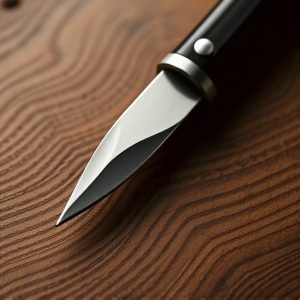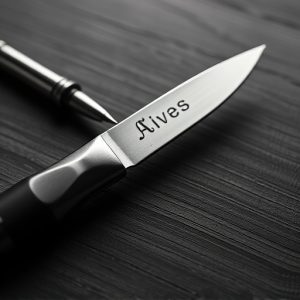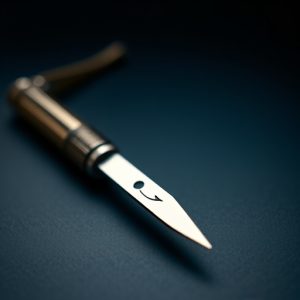Pen with Knife for Self-Defense: A Legal and Practical Guide
The pen with knife is a dual-purpose tool combining a functional writing instrument with a conceale…….
The pen with knife is a dual-purpose tool combining a functional writing instrument with a concealed blade for personal defense. It's designed for legal and responsible carry, offering users the ability to document incidents while providing a means of protection in potentially dangerous situations. The device's discreet nature often allows for carrying where traditional weapons are not permitted, making it an attractive option for personal safety. Its design is user-friendly with high-quality materials, precise engineering, and ergonomic grip for both writing and self-defense. Users must be well-versed in local laws regarding the pen with knife to ensure compliance and must prioritize de-escalation before considering its use as a defense mechanism. Regular maintenance and functionality checks are essential to guarantee readiness. As a concealable self-defense choice, the pen with knife can be a valuable addition to one's safety arsenal when used responsibly, ethically, and in accordance with the law. Proficiency in its deployment requires consistent practice, and ethical decision-making is crucial in self-defense situations. Regular training that simulates real-life confrontations is recommended to ensure users are prepared for both armed and unarmed responses, focusing on precise strikes and movements meant to incapacitate rather than harm.
When considering personal safety, a pen with knife emerges as a discreet yet effective self-defense tool. This article delves into the practicality of this dual-function device, shedding light on its role in protecting oneself. We will navigate the legal landscape surrounding its use, explore its anatomical design for enhanced self-defense, and provide guidance on mastering its application through effective techniques and training. Whether for everyday carry or critical moments, understanding the pen with knife is key to empowering your self-defense strategy responsibly.
Understanding the Pen with Knife: A Practical Self-Defense Tool
The pen with knife, a multifunctional tool often overlooked in the context of self-defense, can be a highly practical choice for those seeking an unassuming means of protection. This device seamlessly integrates the functionality of a writing instrument with that of a compact blade, offering users both the ability to document events as they unfold and a defensive edge should the need arise. The design of the pen with knife ensures that it is legal to carry in many jurisdictions, where traditional self-defense weapons may be restricted. The blade, when extended, can serve as a deterrent or, if necessary, inflict enough force to incapacitate an attacker temporarily. It’s crucial to familiarize oneself with the laws governing the use of such tools in one’s locale and to practice their deployment safely and responsibly.
When considering the pen with knife as a self-defense tool, it’s important to choose one that is both reliable and comfortable for the user. The quality of the materials and the precision engineering behind the mechanism can greatly influence the effectiveness of the tool. Users should select a model that feels natural in their hand, ensuring ease of access to both the writing function and the blade. Regular maintenance and testing of the pen with knife are essential to guarantee it is operational when needed most. Additionally, users should be aware of the legal implications and ethical considerations surrounding its use, always prioritizing de-escalation and personal safety over confrontation. With proper understanding and responsible use, the pen with knife can be a discreet yet effective addition to one’s self-defense strategy.
Legal Considerations When Carrying a Pen with Knife for Self-Defense
When considering the use of a pen with knife for self-defense, it is imperative to be well-acquainted with the legal framework governing such actions. The legality of carrying a pen with knife varies by jurisdiction, and individuals must adhere to state and local laws strictly. In some regions, certain types of assisted-opening pens may be classified as switchblades or automatic knives, which are often prohibited without specific permits or under particular conditions. It is crucial to verify the legal status of your pen with knife in your area before purchasing or carrying one for self-defense.
Owners should also understand that the use of any weapon, including a pen with knife, for self-defense comes with significant responsibility. The law typically expects individuals to retreat from harm’s way if possible and only use deadly force, such as a pen with knife, when there is an imminent threat to their life or wellbeing. Legal defenses for the use of such tools in self-defense are often predicated on the principle that the force used was proportional to the perceived threat and that all other reasonable options were exhausted. Understanding and respecting these legal considerations is not only a matter of compliance but also a critical component of responsible self-defense preparation.
The Anatomy of a Pen with Knife: Features That Enhance Self-Defense Capabilities
A pen with knife, often referred to as a self-defense pen or a defensive writing instrument, is a multifunctional tool designed for both everyday use and personal protection. At its core, this device combines the utility of a writing implement with the tactical capabilities of a discreetly concealed blade. The anatomy of a pen knife for self-defense is meticulously crafted to ensure it serves its dual purpose effectively.
The body of a pen knife typically features a sleek, non-reflective design to maintain a low profile and avoid drawing unwanted attention. It houses a high-quality retractable or ballpoint pen mechanism that allows for smooth writing without compromising the integrity of the blade compartment. The blade itself is usually constructed from durable stainless steel, providing a sharp edge capable of deterring potential threats. A common configuration includes a half-moon shaped blade, which offers a balance between accessibility and concealment, and can be deployed swiftly upon need. Additionally, the pen knife may incorporate an ergonomic grip that not only ensures a secure hold for writing but also provides a comfortable and firm grasp when using the blade, enhancing control and precision in self-defense situations. The pocket clip, often a feature of pens, doubles as a retention mechanism to keep the pen knife securely in place when not in use, yet easily accessible for rapid deployment if threatened.
In terms of self-defense capabilities, the pen with knife is an unassuming tool that can offer significant personal protection. Its primary advantage lies in its unexpectedness; an assailant is unlikely to anticipate a writing instrument to be a weapon, granting the user an element of surprise. The blade’s sharpness and the user’s familiarity with the pen’s handling allow for effective defense mechanisms, such as striking or slashing, to protect oneself. The pen knife’s design is focused on functionality; it serves as a reliable writing tool in daily life while remaining a dependable self-defense device when situational awareness dictates its use.
Effective Techniques and Training for Using Your Pen with Knife in Self-Defense Situations
When it comes to self-defense, a pen with a knife can be a versatile and concealable tool for protection. Effective use of this device requires both knowledge of its capabilities and regular training to ensure proficiency in emergency situations. The first technique to master is the deployment of the knife. In a threatening encounter, swiftly extending the blade from its discreet form is paramount. This action should be practiced until it can be performed with confidence and speed. Once the knife is out, the focus shifts to situational awareness and de-escalation; however, if an attack becomes imminent, you’ll need to be prepared to use the pen with knife defensively. Self-defense training should include scenarios where you practice drawing the blade while maintaining eye contact and a calm demeanor to communicate your intent to disengage. If confronted, aim to create distance between yourself and the assailant, using the knife’s presence alone as a deterrent.
Training for self-defense with a pen with a knife extends beyond mere technique; it also encompasses legal considerations and ethical decision-making. It’s crucial to understand the laws regarding defensive use of such tools in your jurisdiction, as well as to recognize situations where escape is the safer option. Regular drills that simulate real-life encounters will help you react instinctively and appropriately. These should include both armed and unarmed scenarios, emphasizing strikes, stabs, and slashes that are designed to incapacitate rather than cause serious harm. Additionally, maintaining the pen form as a disguise until the threat is imminent can provide an element of surprise. Combining this with situational awareness and assertive body language can often resolve conflicts before they escalate to the point where the knife must be used. Consistent practice and understanding the legal framework will ensure that in a self-defense situation, you are prepared to use your pen with knife effectively and responsibly.


